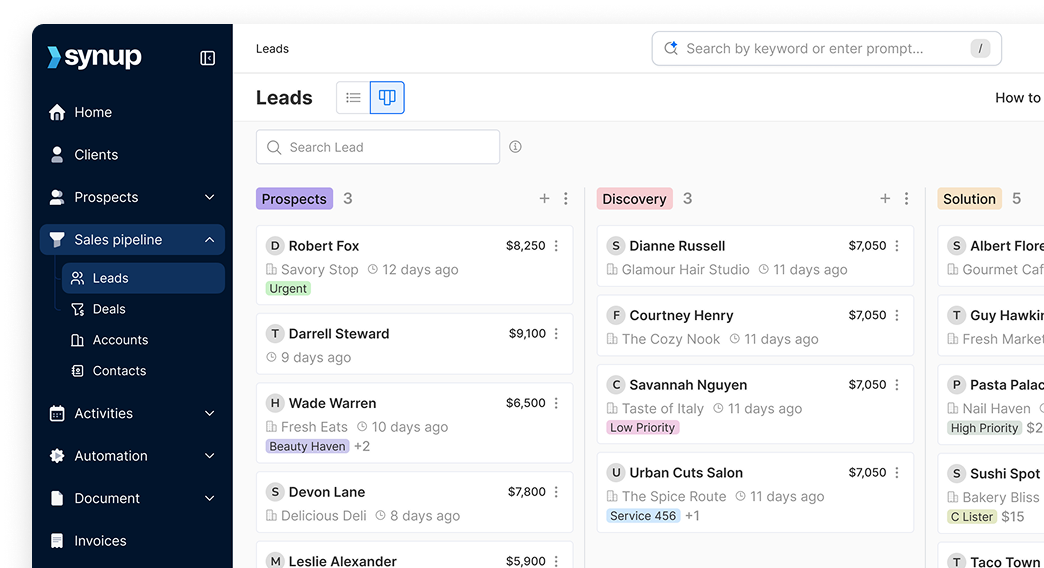Everything you should know about effective Social Media Ad Targeting
Running successful social media ads isn’t about blindly spending money, it’s about precision. The more accurately you target your audience, the better your results.
Whether you’re an agency running client campaigns or a brand refining your ad strategy, understanding how social platforms target users and how to leverage that for better ROI is crucial.
Let’s understand it better with this article.
What is Social Media Ad Targeting?
Social media ad targeting is all about making sure your ads land in front of the right people. Platforms like Facebook, Instagram, LinkedIn, and TikTok gather tons of user data, letting advertisers fine-tune their audience based on demographics, interests, behaviors, and even real-time activity. Instead of casting a wide net, you can zero in on users most likely to engage with your content, click through, and convert. The better your targeting, the more relevant your ads feel, leading to higher engagement, stronger brand connections, and ultimately, better results.
For agencies running social ad campaigns, understanding how these platforms target users is crucial. It helps in crafting more effective ad strategies, optimizing spend, and ultimately driving better ROI.
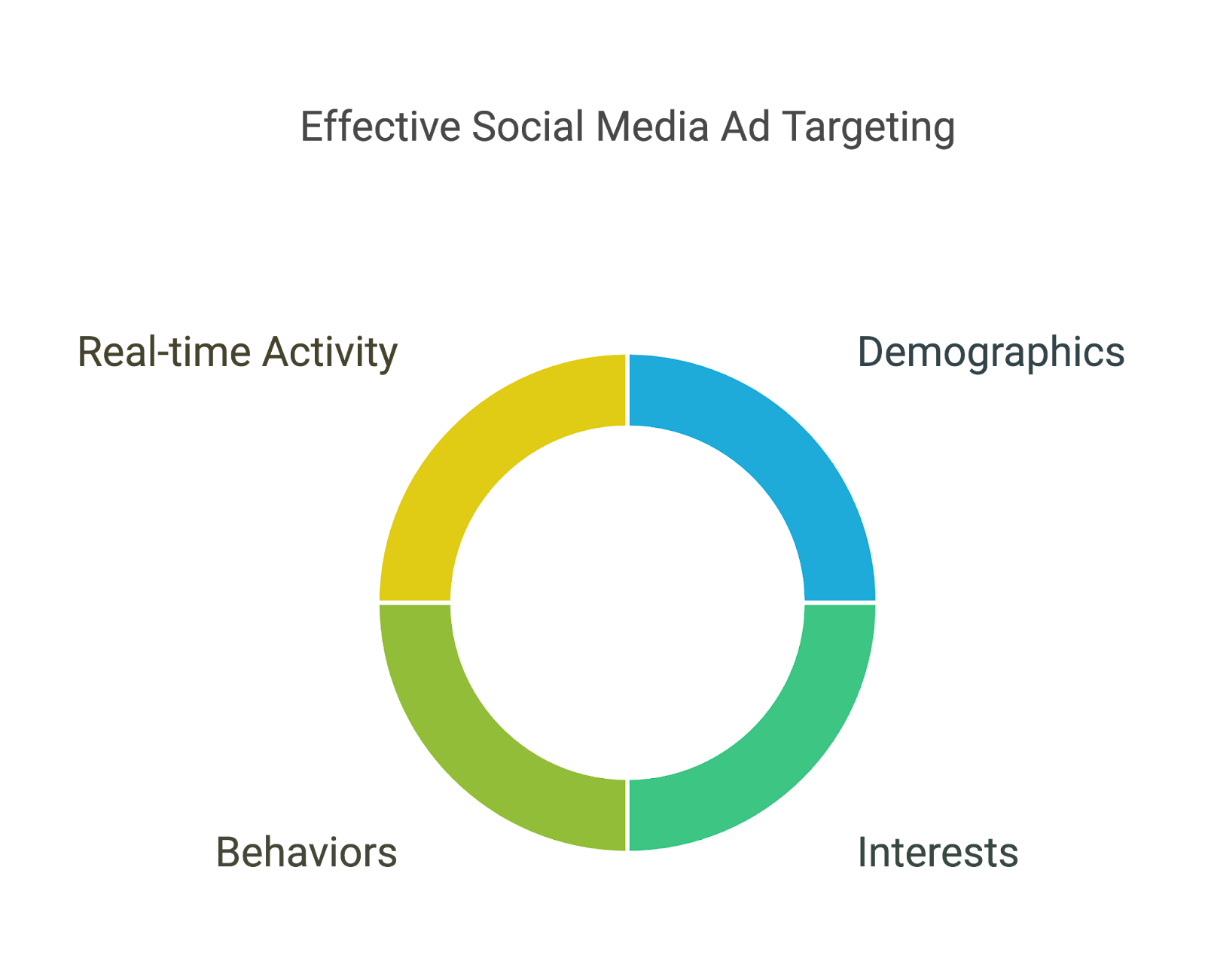
Let’s break down the mechanics of social media ad targeting and explore how agencies can leverage these tools.
First things first,
Social platforms use a combination of user data, machine learning, and real-time behavior tracking to refine ad targeting.
Here’s a breakdown of how they reach their target audience.
1. Demographic Targeting
Every social media platform collects user data at sign-up and refines it over time based on user interactions. This allows advertisers to reach specific audience segments based on general characteristics like age, gender, location, education, job title, and income bracket.
How it Works:
- When users sign up, they provide basic demographic details (age, gender, location).
- As they engage with the platform, data is further refined based on profile details (education, job title, interests, etc.).
- Some platforms estimate income levels based on purchase behavior, property ownership, and job roles.
For agencies, demographic targeting is a baseline, it ensures that campaigns don’t waste budget on users who aren’t a good fit. If your client sells luxury real estate, for example, targeting users with higher income brackets makes far more sense than a broad approach.
2. Interest-Based Targeting
Social platforms are constantly tracking user engagement to understand what people are interested in. From the pages they follow to the content they interact with, every action helps categorize users into interest groups.
How it Works:
- AI-driven algorithms analyze user behavior: what they watch, engage with, and search for.
- Platforms segment users into interest clusters based on sustained engagement patterns.
- Advertisers can target these interest groups to refine their reach.
If a travel agency wants to target adventure travelers, it can focus on users who follow travel influencers, engage with airline deals, or browse destinations on Instagram Explore.
💡 Pro Tip for Agencies: Interests are dynamic. A user engaging with baby product content today might be categorized under “Parenting” temporarily, even if they don’t usually fall into that category. This is why continuous audience refinement is key in campaign management.
3. Behavioral & Intent-Based Targeting
Social media platforms don’t just analyze interests, they also track real-time behaviors to determine intent. If someone visits a product page but doesn’t complete a purchase, that signals high intent.
How it Works:
- Platforms track user actions such as website visits, cart abandonment, and past purchase history.
- Retargeting tools like Facebook Pixel and TikTok Pixel allow advertisers to re-engage users who previously interacted with their brand.
- Lookalike audiences help reach users with similar behaviors and interests.
For example, An e-commerce brand can retarget users who added items to their cart but didn’t check out, nudging them with a limited-time discount ad.
Platform-Specific Ad Targeting
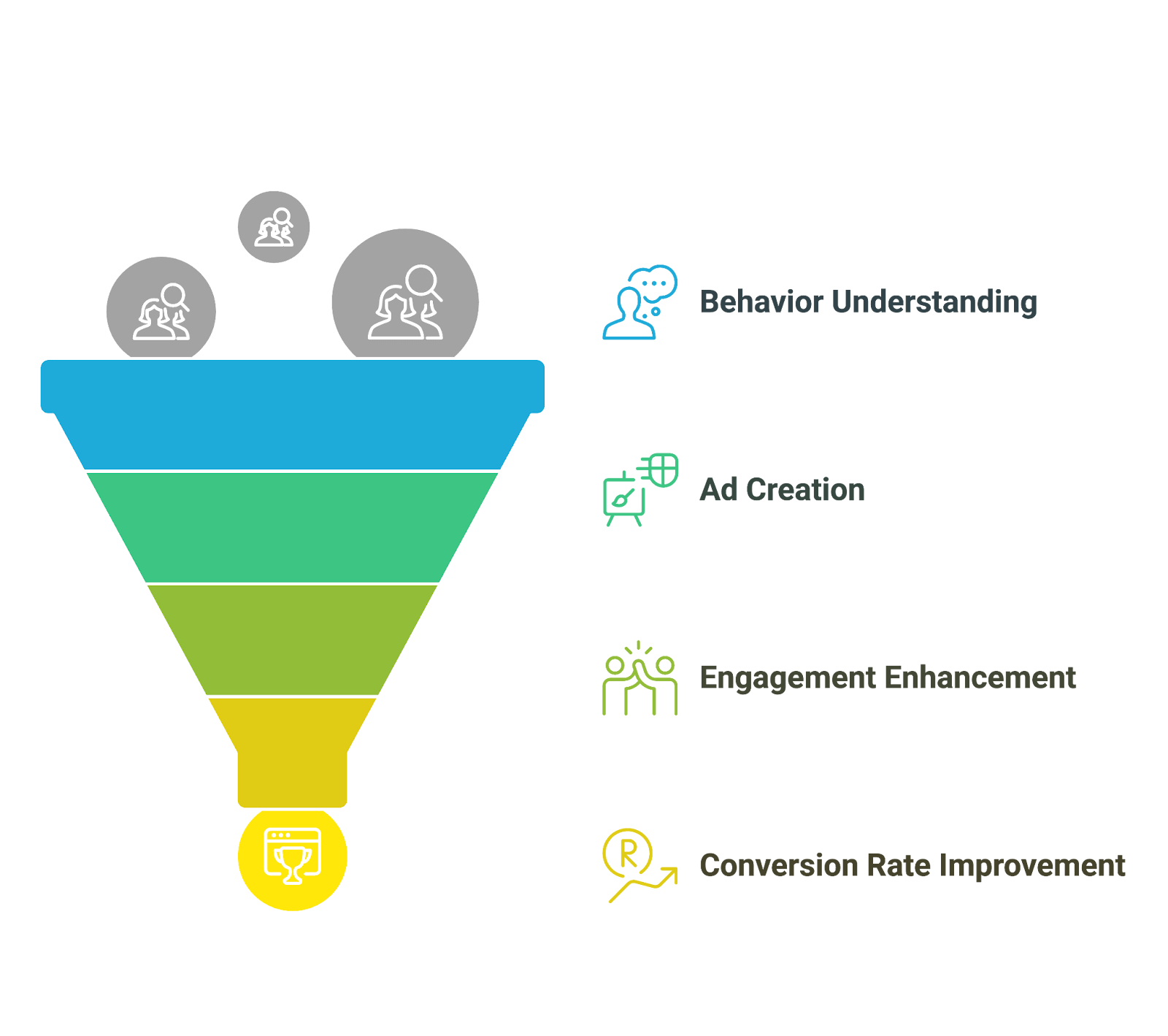
1. Meta & Instagram Ads
Meta’s platforms are still the go-to for digital advertising, thanks to their insane targeting flexibility. Whether it’s demographics, interests, behaviors, or custom audiences, you’ve got plenty of ways to reach the right people.
Plus, with AI-powered optimization, retargeting, and ad placements across Facebook, Instagram, Messenger, and Audience Network, you can fine-tune your campaigns to drive real results.
Demographic Targeting
Meta allows advertisers to refine their audience based on fundamental demographic details, ensuring that ads reach users who match specific personal characteristics. Some key aspects of demographic targeting include:
- Age & Gender: Advertisers can specify age ranges (e.g., 18-24, 25-34) and target specific genders based on the product or service.
- Location: Ads can be shown to users in a particular country, state, city, or even a specific radius around a business location.
- Language: Useful for targeting multilingual audiences or tailoring ads to users who prefer a specific language.
- Education Level: Allows segmentation based on education status, such as high school, college students, or graduates.
- Relationship Status: Businesses targeting newlyweds, engaged couples, or single individuals can use this filter to reach relevant users.
- Work & Job Title: Useful for B2B advertising, allowing companies to target professionals based on their job roles or industries.
Interest Targeting
Meta’s interest-based targeting enables advertisers to reach users based on their hobbies, preferences, and online behavior.
- Liked Pages & Content Interactions: Meta analyzes the pages a user follows, the content they engage with, and the topics they interact with.
- Entertainment Preferences: Users can be targeted based on their interests in movies, TV shows, books, and celebrities.
- Hobbies & Activities: Businesses can target users based on activities like fitness, gaming, traveling, photography, and more.
- Shopping & Fashion: Allows brands to advertise to users who are interested in luxury brands, online shopping, or specific fashion styles.
- Food & Dining: Restaurants and food delivery services can reach users based on their interest in different cuisines or dining habits.
Behavioral targeting
Behavioral targeting allows advertisers to reach users based on their past actions, purchase habits, and device usage. Meta collects behavioral data through various means, including interactions within its platforms and third-party partnerships.
Some key behavioral targeting factors include:
- Device Usage: Advertisers can target users based on whether they use mobile, desktop, Android, iOS, or specific device models.
- Online Shopping Behavior: Businesses can reach users who frequently shop online, browse e-commerce websites, or engage with product catalogs.
- Travel Behavior: Airlines, hotels, and travel agencies can target frequent travelers, business travelers, or those who have recently returned from trips.
- Purchase Intent & Spending Habits: Users who have shown interest in buying specific products or fall into high-spending categories can be targeted.
- Event-Based Targeting: Brands can reach users based on life events like engagements, birthdays, anniversaries, or recent relocations.
Custom Audiences
Custom Audiences allow businesses to retarget users who have already interacted with their brand, increasing the chances of conversion. Advertisers can create custom audiences based on:
- Website Visitors: Meta’s pixel tracking enables brands to retarget users who have visited specific pages of their website but did not complete a purchase or action.
- App Activity: Mobile apps linked to Meta can retarget users based on in-app actions, such as cart abandonment, sign-ups, or specific feature usage.
- Customer Lists: Businesses can upload their email lists, phone numbers, or customer data to show ads to existing customers.
- Engagement on Meta Platforms: Advertisers can retarget users who have interacted with their Facebook or Instagram pages, watched videos, filled out lead forms, or clicked on previous ads.
Lookalike Audiences
Lookalike Audiences help brands expand their reach by finding new users who share similar characteristics with their existing customers. Meta’s algorithm analyzes data from a business’s Custom Audiences and identifies users with similar traits. Some key factors that influence.
- Customer Similarity: Meta compares user behavior, interests, and demographics to find people likely to engage with a brand.
- Size & Precision: Advertisers can adjust the percentage match (1%-10%) to either focus on a highly precise lookalike group or a broader audience.
- Data Source Variety: Lookalike Audiences can be created from website visitors, email lists, video viewers, or any existing Custom Audience.
- Global or Local Reach: Advertisers can expand into new markets by finding similar users in different countries or regions.
Advanced Ad Targeting
Running ads without refining your targeting is just throwing money away. The more strategic you are, the better your results. Here are a few advanced targeting techniques to make sure every ad dollar counts.
1. Sequential Messaging
People don’t always convert on the first ad. They need a little push, sometimes a few, before they take action. Sequential messaging helps you guide them through the funnel with a structured series of ads instead of hitting them with the same thing over and over.
How it works:
- The first ad introduces the product or service, no hard sell, just awareness.
- The second ad highlights key benefits, testimonials, or pain points it solves.
- The third ad drives action with a limited-time discount, free trial, or some other compelling offer.
2. Dayparting (Time-Based Targeting)
Just because you can run ads all day doesn’t mean you should. Sometimes drives better engagement and conversions than others. Dayparting lets you schedule ads when your audience is most active.
How it works:
- Check campaign data to see when users are clicking, engaging, and converting.
- Run ads during high-activity windows and pause them when engagement drops.
- Adjust by platform, Instagram might work better in the evenings, and LinkedIn during work hours.
3. Exclusion Targeting
Not every impression is worth paying for. Exclusion targeting helps you cut out users who don’t need to see your ads, like existing customers if you’re running an acquisition campaign.
How it works:
- Exclude past buyers from new customer ads.
- Filter out job seekers if your campaign is for products, not hiring.
- Remove locations where your service isn’t available.
4. Predictive Targeting
Instead of manually tweaking your targeting, let AI handle it. Predictive targeting uses machine learning to analyze past user behavior and predict who’s most likely to take action.
How it works:
- AI analyzes data like clicks, site visits, and purchase history.
- Campaigns adjust dynamically based on real-time performance.
- You target high-intent users instead of guessing who might convert.
Ad Example:
Aday, a sustainable clothing brand, ran an Instagram ad that directly addressed common wardrobe challenges. The ad featured high-quality images of their versatile clothing line, emphasizing how their pieces could simplify and enhance daily dressing. This approach resonated with their target audience by offering practical solutions to everyday problems, leading to increased engagement and conversions.

2. X (Formerly Twitter)
X is all about what’s happening right now, making it the perfect platform for brands that want to stay relevant and join trending conversations.
Here’s how you can target the right people at the right time:
1. Keyword Targeting
Think of this as showing up exactly when someone is talking about something relevant to your brand. If users search for or tweet about specific keywords (like "best running shoes" or "summer skincare"), your ad can appear in their feed. This is a great way to ride the wave of trending topics and reach users when they’re actively engaged.
2. Follower-Based Targeting
Want to reach people who already follow your competitors, industry influencers, or thought leaders? X lets you do just that. If you sell fitness gear, for example, you can target users who follow big names in the fitness space. These users are already interested in your niche, making them more likely to engage with your ads.
3. Interest & Demographic Targeting
Similar to Meta (Facebook/Instagram), X allows you to refine your audience based on what they like and who they are. You can target users interested in specific topics (tech, fashion, sports) and filter by age, location, and even language. This ensures your ads land in front of the right people instead of a random audience.
4. Event Targeting
Major live events, sports finals, award shows, and global conferences, generate a ton of real-time buzz. X lets you place your ads in front of users engaging with these moments.
For example, if there’s a big football game, a sports drink brand can target fans discussing it. This helps brands stay part of cultural conversations as they unfold.
Ad Example:
Yemeksepeti is a Turkish online food delivery service operating in over 60 cities. They took to Twitter to increase their reach. The advertising campaign was a big success even though Yemeksepeti only used two videos. One video featured traditional Turkish food, and the other was focused on burgers. This approach worked because it catered to two different audiences.
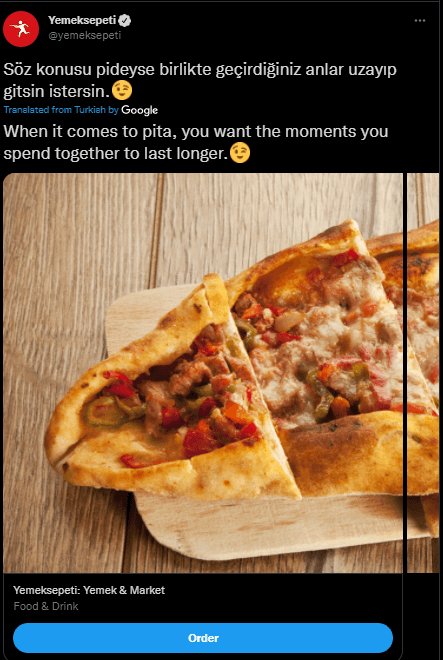
As the campaign went on, the company saw a 67% increase in its click-through rate and a decrease in cost-per-click.
3. LinkedIn
If you're in B2B marketing, LinkedIn is the place to be. It’s designed for professionals, making it the best platform to reach decision-makers, industry experts, and business buyers.
Here’s how you can target the right audience:
Job-Based Targeting
Imagine you’re selling a marketing automation tool. Instead of guessing who might be interested, LinkedIn lets you target people based on their job title (e.g., Marketing Director), industry (Tech, Healthcare), company size (small startups vs. Fortune 500), and seniority (entry-level vs. C-suite). This ensures your ad is seen by the right professionals who actually make purchasing decisions.
Company Targeting
Want to get in front of employees at a specific company? LinkedIn lets you do that. If you’re running an account-based marketing (ABM) campaign, you can target people working at your dream client’s company, whether it's startups, enterprises, or competitors. This is perfect for B2B brands that need to nurture high-value accounts.
Skill & Interest Targeting
Let’s say you’re offering a certification course in data analytics. Instead of targeting a broad audience, you can reach users who have skills like “SEO,” “project management,” or “financial modeling” listed on their LinkedIn profiles. You can also tap into users interested in topics relevant to your business, making your ads more relevant and effective.
Matched & Lookalike audiences
Already have a list of website visitors, CRM contacts, or people who engaged with your LinkedIn content? Retarget them with ads to stay top of mind. Want to expand your reach? LinkedIn can find lookalike audiences, people with similar traits to your best customers - helping you attract new leads that are more likely to convert.
Ad Example:
Adobe utilized LinkedIn to share insightful articles, industry reports, and expert opinions, establishing itself as a thought leader in the creative software space. By providing valuable content tailored to professionals, Adobe fostered trust and credibility among its audience, leading to increased brand loyalty and engagement. Socialinsider

These campaigns excelled by understanding their platform's unique strengths and aligning their content accordingly. By addressing audience needs, encouraging participation, and providing value, these brands achieved remarkable success across social media channels.
4. TikTok
TikTok’s algorithm is next-level when it comes to showing content to the right people. It learns fast and delivers videos based on user behavior, making it a goldmine for brands looking to get discovered.
Interest & Behavior Targeting
TikTok tracks what users watch, like, share, and comment on. If someone spends hours watching skincare tutorials, TikTok will serve them more beauty content—including ads for skincare brands. This makes it easy for businesses to reach people genuinely interested in their niche.
Hashtag Targeting
Users follow and engage with trending hashtags like #FitnessJourney or #DIYHomeDecor. Brands can target these users by running ads tied to relevant hashtags. If a challenge or trend is blowing up, this is a great way to insert your brand into the conversation.
Creator & Community Targeting
TikTok is all about creators and niche communities. You can target users who follow specific creators (like influencers in beauty, gaming, or fashion) or people who interact with content in specific categories. This lets brands tap into highly engaged audiences that already trust the creators they follow.
Lookalike & Custom Audiences
Want to retarget users who’ve interacted with your TikTok content or website? You can do that. TikTok also helps you find lookalike audiences along with people with similar interests and behaviors as your existing customers, so you can expand your reach in a way that still feels targeted.
Ad Example:
To promote its new fragrance "Perfect," Marc Jacobs initiated the #PerfectAsIAm challenge on TikTok. The campaign encouraged users to create videos celebrating their uniqueness, aligning with the fragrance's theme of self-acceptance. Collaborating with internet personality Rickey Thompson, the challenge amassed over 6 billion views and saw participation from 2 million users. This user-generated content approach fostered community engagement and significantly boosted brand visibility.
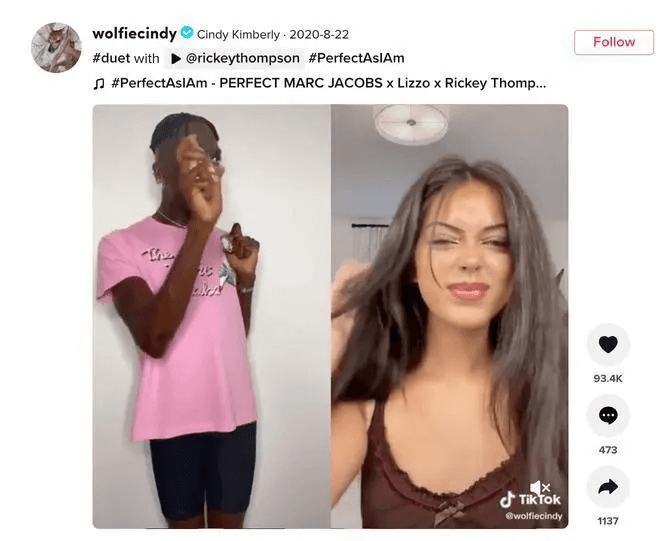
5. Pinterest
Pinterest isn’t just a social media platform, it’s a visual search engine. People come here to find ideas, get inspired, and plan purchases, making it an incredible place for brands selling physical products.
Keyword & Search Targeting
Unlike other social platforms, Pinterest works a lot like Google. Users actively search for things like “fall outfit ideas” or “DIY home office setup.” Ads can appear in these search results, putting your brand in front of users when they’re already looking for products like yours.
Interest Targeting
Pinterest tracks what users Pin and engage with. If someone has a board full of “Minimalist Home Decor” ideas, a furniture brand can target them with ads showcasing sleek, modern pieces. This helps brands connect with users based on their tastes and long-term interests.
Shopping & Catalog Targeting
E-commerce brands can upload their product catalogs and create shoppable ads. Pinterest then serves these ads to users with high purchase intent, people who are actively browsing for similar products. This makes Pinterest a powerful sales channel, especially for fashion, home decor, and beauty brands.
Actalike & Custom Audiences
Pinterest’s version of lookalike audiences, called Actalike Audiences, helps brands reach new users similar to their existing customers. You can also retarget users who’ve engaged with your Pins or visited your website, keeping your brand top-of-mind as they move from browsing to buying.
Ad Example:
Michaels, a prominent arts and crafts retailer, launched an innovative campaign using interactive video pins that provided a 360-degree view of craft projects. This immersive experience allowed users to explore projects from all angles, inspiring creativity and encouraging them to visit Michaels for supplies. By leveraging Pinterest's visual-centric platform, Michaels effectively engaged users, leading to increased interest and store visits.

Final Thoughts
There’s no one-size-fits-all when it comes to running ads on social media. Each platform has its own strengths, and the key is knowing where your audience spends their time and how they interact with content.
Here’s how I think about it:
If I want to reach a broad audience with precise targeting, I go with Meta (Facebook & Instagram). These platforms have the best data for detailed audience segmentation, whether it’s demographics, behaviors, or interests. Plus, the retargeting options are solid, making it a great choice for e-commerce brands and lead generation.
If I need real-time engagement or want to capitalize on trends, X (formerly Twitter) is my go-to. It’s perfect for running keyword-based ads that tap into ongoing conversations, especially around live events, news, and viral topics.
For B2B marketing, LinkedIn is unbeatable. The job-based targeting lets me get super specific, whether I’m looking to reach C-level executives, marketing managers, or employees at a particular company. If I’m running an account-based marketing (ABM) campaign, LinkedIn is a no-brainer.
If I want to engage younger, trend-driven audiences, TikTok is where I invest. TikTok’s algorithm is scary and good at pushing content to the right people. Whether I’m targeting based on interests, hashtags, or creator communities, I know I’ll be reaching users who are genuinely engaged.
For intent-driven shoppers, Pinterest is a hidden gem. Unlike other platforms, people come to Pinterest actively looking for ideas and products. The keyword-based targeting is more like Google than social media, making it a great place to advertise to users who are already considering a purchase.
What’s the Best Strategy?
For me, it’s never about choosing just one platform, it’s about mixing and matching based on my audience and goals. If I’m running an e-commerce campaign, I’ll probably use Meta for retargeting, TikTok for awareness, and Pinterest for high-intent shoppers. If it’s B2B, I’ll lean heavily on LinkedIn for decision-makers and X for brand awareness.
At the end of the day, the best ad strategy is the one that meets your audience where they already are. That’s the approach I take, and it’s what makes social media advertising so powerful when done right.
FAQs
What is the 50/30/20 rule for social media?
The 50/30/20 rule suggests splitting content into 50% value-driven posts (educational, entertaining, or engaging), 30% shared content (curated from others or collaborations), and 20% promotional content. It helps maintain a balance between audience engagement and direct marketing.
What are the 5 P's of social media?
The 5 P’s, Plan, Produce, Publish, Promote, and Prove - outline a structured approach to social media marketing. You start by planning your content, creating it, publishing it at the right time, promoting for reach, and finally tracking results to refine your strategy.
What is the 5 5 5 social media strategy?
This strategy involves engaging with five new people, interacting with five existing connections, and posting five pieces of content daily. It’s designed to build relationships, grow your audience, and keep your brand active across platforms.
How are social media ads targeted?
Social media ads use a mix of demographic, behavioral, and interest-based targeting. Platforms let you refine audiences by factors like age, location, past interactions, search history, and even engagement with specific content, ensuring your ads reach the right people.




